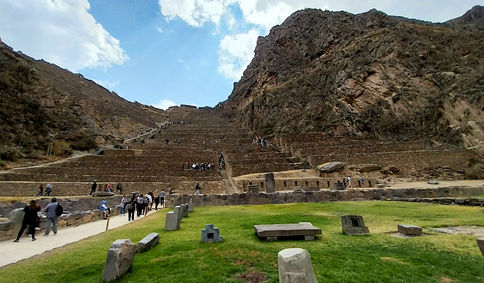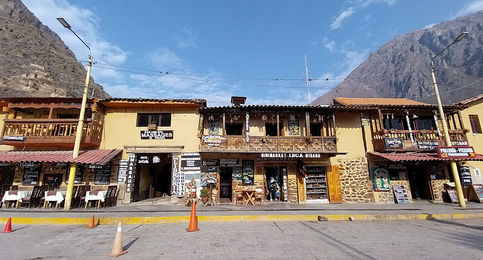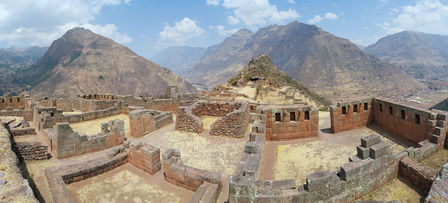
Cusco and the Sacred Valley
Peru
The historic center of Cusco is beautiful. You wouldn't think it when you arrive by bus on the outskirts of the city, but once you enter the old town you realise that this is probably one of the most charming places in all of Peru. From the narrow, cobbled streets to the eye-catching archways, the intricate stonework to the plethora of old, imposing churches, every direction you look makes you say 'wow'. Unfortunately, that beauty is diminished by the inescapable tourism that you are confronted with at every turn. Every building is a hostel, restaurant or souvenir store. The streets are congested with taxis and tourist buses, while the pavements are filled with numerous tour groups. Around the main plaza are constant calls for food, drinks, handicrafts, artwork, massages and, of course, tours. It's loud, crowded and exhausting. We retreated to the edges of the old town as much as possible for some much-needed relief. (I recognise the hypocrisy of saying all of this, being a tourist myself and adding to the problem.)
There were miradors aplenty on the hills surrounding Cusco, all within easy walking distance from the centre. From San Blas to San Cristobal to the imposing Cristo Blanco statue that stares over the city, as well as views from the numerous restaurants and bars nearby to these lookouts, seeing the historic centre from above was not difficult. They all showed a sea of brown roofs, with the odd church popping out higher than the rest. It was incredible to see just how vast Cusco was.
Cusco was the capital of the Inca Empire from the 13th to the 15th centuries. Archeological remains can be found all around the city, such as the distinctive stone walls that were built without mortar and contain blocks that had been sculpted to fit together perfectly. Coricancha was the most important and sacred temple during this time, where all sorts of deities were revered. That was until the Spanish arrived, demolished most of the buildings and looted the gold plates that covered the interior walls. They then built a catholic church in its place, incorporating some of the remaining structures that weren't knocked down. Now it's an elegant blend of the 2 styles, although there is a stark contrast between Inca and Spanish stonework. Inside, I wandered through courtyards, archways and gardens, briefly admired the ceiling murals and religious artwork, then spent a long time perusing the contemporary art on display. I managed to time my visit well; as I was leaving, dozens of tour groups were arriving that would have quickly filled the venue.

The Sacred Valley is a region north of Cusco that formed the heartland of the Inca Empire. To visit the various sites scattered through here, we combined both a tour, for the history lesson and for ease of getting around, and independent exploration, to have more time to explore and appreciate the ruins.
First stop was Chinchero, which used to be a city just as large as Machu Picchu. When the Spanish arrived, they seized control and started constructing buildings in their own style, including churches that are still used today (evidenced by confetti on the ground from last weekend’s wedding). Along with a couple of hundred other tourists, we walked along the walls and terraces of a small area of ruins before perusing the souvenir and food stalls in town.
After this, we visited a traditional handicrafts centre, where there were woollen products galore on display as well as guinea pigs running around multi-tiered enclosures. The animals weren’t there as part of a petting zoo - they were solely for eating, being a major part of the Inca diet. People throughout the Andes continue to eat guinea pigs to this day, and they are considered a ‘must-try’ for tourists (no thanks). We were given a demonstration on how the wool was washed, spun and dyed, which was interesting except for the constant references to taking the wool from baby alpacas and squashing cochineal insects to create the red pigment.
Back on the bus, were given a long speech in Spanish about the local spirit pisco, made by distilling fermented grape juice. We were then offered a tasting of a peppermint pisco and a coffee pisco while driving to the next site. It was 9.15 a.m. and we hadn't eaten anything yet, but why not, let's get on the alcohol.
Next up was the Maras Salt Flats. So far, we had been driving across bare plains, but as we neared Maras, stunning mountain scenery came into view. Peaks soared overhead, some with patches of snow on top. The salt flats themselves were just as picturesque, containing numerous tiny pools of water of various shades of brown bordered by rings of white salt. Our guide pointed out the saltwater being pumped up from underground at a pleasant 32°C. It was then funnelled out across the flats and left to dry. Three types of salt were produced: brown salt, higher in magnesium and purely for medicinal purposes; pink salt, higher in iron and similar to Himalayan salt; and white salt, the highest quality and used in food. Up to 3,000 tonnes of salt are churned out every year, which seems like a phenomenal amount.
The village of Maras was a place that time forgot. All the narrow streets were lined with single storey, mud brick buildings with blue wooden doors. I don’t think the appearance had changed in hundreds of years, except for the presence of cars and electricity. Our tour stopped at a store that specialised in local organic salt products, but I think the dozens of different types of chocolates for sale were the moneymakers. We were given pieces of fried corn kernels and plantain chips to dip into salts flavoured with a range of herbs, spices, chillis and aliums. Danny was impressed enough to buy several small packets to carry with him on our travels.

Following Maras we drove to Moray, which wasn't grand in size but was impressive in engineering. It was a sinkhole that the Inca developed into a tiered farm for a variety of crops. From above it looked like a giant avocado. Somehow, the Inca had figured out how to construct each layer so it had a different temperature, humidity and wind pattern that would be suitable for different plants. They then brought crops up from the lower altitudes and gradually adapted them to the higher elevations (Moray sits at 3,500 m). This allowed them to grow a wider range of foods and textiles, such as coca and cotton, up in the Andes. Nowadays, people go to university to figure this stuff out.
After a buffet lunch of mostly meat and potatoes, we made our way to the town of Ollantaytambo, located at the intersection of 3 valleys. Ollanta (for short) used to be a large Inca city, popular as a stopover point for people travelling between other towns. A large battle took place here between the Inca and the Spanish in 1537. Using local knowledge, the Inca surprisingly prevailed, their only weapons being slingshots with rocks up against the Spaniards' horses and swords. The Spanish weren't too happy about that, so when they finally conquered the Inca Empire, they destroyed much of the city. Most of the houses in the town today are made with rocks taken from the old city. It was incredibly lucky the Spanish didn't venture 50 km up one of the valleys, otherwise the same fate would have come to Machu Picchu.
The ruins of Ollanta are enormous in height more than breadth. A series of stone walls terraced their way up a steep mountainside to a jumble of ruined structures. Our group slowly ascended the steps, with our guide pointing out notable features at each stage. On the opposite mountain we could see a row of windows carved out of the rock face, which was originally used for food storage. The cooling winds from the nearby glaciers kept food cold enough that it could be stored safely, sort of like an early refrigeration system.
Halfway up the mountain was the Temple of the Sun, built using large granite rocks that had been hauled up to the site from many kilometres away. Projections were carefully carved out of the rocks that created specific shadows at certain times of the year, creating a primitive calendar. They were also aware of when the sun would hit certain parts of the surrounding mountains at the solstices and equinoxes, giving them important information for the timing of their harvests.
Here was where we left the tour, taking our time to explore more of Ollanta by ourselves. We continued climbing up the mountain to further ruins, from where we were granted views down all 3 valleys. Despite staying an hour longer, tour groups continued to roll in the entire afternoon, meaning we were nearly always caught up in a crowd of people.
The town of Ollanta was attractive but very touristy. It wasn't hard to find happy hour deals around the centre square, and the place calmed down considerably once the tour buses left. It was a lovely place to explore in the late afternoon and to spend the night.

The next morning, we caught a colectivo, a tuk-tuk, another colectivo, then a taxi through the valley from Ollanta to Pisac, our final destination in the Sacred Valley. This was the most extensive and well preserved of the ruins, tumbling several hundred metres down the side of a mountain. When we arrived there were already countless tour buses lined up at the entrance, but the vastness of Pisac meant it never felt congested.
We started at the top of the mountain, where terraces cascaded away far below us. On the summit was the site of an old Inca neighbourhood, with a variety of structures we could walk around that provided views out across the valley. After only descending for a couple of minutes, we found we had left the tour groups behind - the fact that they only had the chance to see a tiny fraction of Pisac was a major reason we wanted to do this one by ourselves. Although the wisdom supplied by a guide would have been valuable, I was happy to exchange it for the freedom to see the entire site.
Somehow we ended up on a side path that skipped some of the more notable ruins, so we had to double back up the hill to visit them - not fun at the high altitude. Historically, Pisac had religious, military, ceremonial, residential and agricultural uses, plus it contained one of the largest Inca cemeteries in South America (estimates are that over 10,000 tombs were located here at one point). The various neighbourhoods around the site once contained palaces, temples and watchtowers, but now most of it was reduced to a few foundational stones and low walls. Once again, we were impressed by the classic Inca stonework that was on full display here. We had no idea what we were looking at most of the time, but in every direction the views were incredible.
I presumed we would only spend an hour or so at the ruins, but somehow 2 and a half hours had elapsed. It was by far the most impressive site we had visited in the Sacred Valley, and hopefully it was a good prelude for the big one, Machu Picchu. At the bottom we emerged in modern Pisac, which was colourful, neat and clearly catering for the tourist market. Ideally we would have spent some time here checking out the restaurants and souvenir stores, but we needed to return to Cusco to prepare for our next adventure.















































